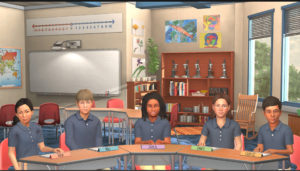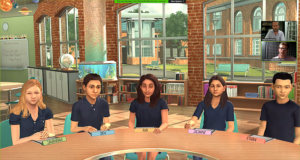
The biggest and longest running educational conference here in the UAE is GESS which takes place at the World Trade Centre each year. This year was the sixth time I have attended and in between presentations, I wandered the vast trade show looking for something new and inspiring. Over the years I have come across many little gems in amongst the sea of interactive whiteboards including meeting a little augmented reality company in 2014 called Zientia who went on to become the acclaimed Arloon. This year, one thing stood out to me above everything else. Something unique and unlike anything I had seen before or since. It’s produced by UK company Connect and is called C-Live.
Now at first I wasn’t sure whether C-Live was a good fit for VirtualiTeach as it is neither AR nor VR. Aligning with Paul Milgram’s Virtuality Continuum, it’s more like a form of augmented virtuality in that it’s a virtual simulation run remotely by a member of the Connect team which you can interact with orally. You see the virtual class of students in C-Live can “see” you via your webcam.
My first response when I tried it was “this can’t be AI.” It was too intuitive and adaptive to be a machine. In reality Connect employs Simulation Specialists who are excellent at two things – acting as children and understanding special educational needs. This is the man thrust of the company you see – training SEN teachers (or indeed any teacher) in ways to deal with specific learning needs, be it ADHD, autism, emotional disorders or other issues. It’s a brilliant concept as a training tool since it would never really be possible to hone the skills needed to work with SEN kids in reality. It’s also a great example of the “Virtual Rehearsal” concept I covered in my Why VR article recently as teachers would be able to practise dealing with particular traits in a safe environment where they have no fear of taking the wrong approach or saying something “wrong.” It’s a testament to Jess and the other Simulation Specialists that they can really draw you into the virtual classroom, even despite the absence of a VR headset, and make these kids seem real.
Click here to read an interesting case study of C-Live in use from Bath Spa University.

This week I was lucky enough to get to see the new version of C Live in action and it has leapt forwards a great deal in terms of aesthetics. The avatars are far more realistic and are all in constant motion to breath life into them even when not being puppeteered by the Simulation Specialist. Here’s a look at the new version in action:
One thing that struck me this week whilst seeing C-Live in action again is that it is the closest thing I’ve seen to something I have spoken about at various events – the synergy between virtuality and theatre. I think that we will soon see drama groups, acting companies and the like working as a part of live VR simulations on a regular basis. I see this being particularly relevant to historical themed experiences. Think of it like the evolution of the living museum concept – where actors bring an historical site to life by reenacting roles from the past.

Imagine this – you take your class into a shared VR experience of a Viking village. Upon arrival you are greeted by a Viking warrior who directs you towards different activities taking place around the village. This would be an actor wearing the avatar of a Viking. An actor who is well-versed in Norse history and brings the character to life authentically. It’s essentially what C-Live are doing right now except that they are portraying modern day students using a deep understanding of SEN issues and additional learning needs. As such they really are ahead of the curve!
This is a guest blog post by Steve Bambury, who is the Head of Digital Learning and Innovation across Jess Dubai. This post was originally published on his website VirtualiTeach which you can access here.